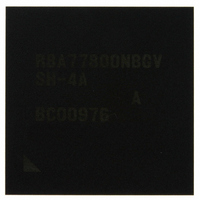R8A77800ANBGAV Renesas Electronics America, R8A77800ANBGAV Datasheet - Page 449

R8A77800ANBGAV
Manufacturer Part Number
R8A77800ANBGAV
Description
IC SUPERH MPU ROMLESS 449-BGA
Manufacturer
Renesas Electronics America
Series
SuperH® SH7780r
Datasheet
1.R8A77800ANBGV.pdf
(1342 pages)
Specifications of R8A77800ANBGAV
Core Processor
SH-4A
Core Size
32-Bit
Speed
400MHz
Connectivity
Audio Codec, MMC, Serial Sound, SCI, SIO, SPI, SSI
Peripherals
DMA, POR, WDT
Number Of I /o
75
Program Memory Type
ROMless
Ram Size
16K x 8
Voltage - Supply (vcc/vdd)
1.15 V ~ 1.35 V
Oscillator Type
External
Operating Temperature
-20°C ~ 75°C
Package / Case
449-BGA
Lead Free Status / RoHS Status
Lead free / RoHS Compliant
Eeprom Size
-
Program Memory Size
-
Data Converters
-
Available stocks
Company
Part Number
Manufacturer
Quantity
Price
Company:
Part Number:
R8A77800ANBGAV
Manufacturer:
Renesas Electronics America
Quantity:
10 000
- Current page: 449 of 1342
- Download datasheet (7Mb)
Section 11 Local Bus State Controller (LBSC)
11.5.10 Bus Release and Acquire Sequence
The LBSC holds the bus itself unless it receives a bus request.
On receiving an assertion (low level) of the bus request signal (BREQ) from off-chip, the LBSC
releases the bus and asserts (drives low) the bus use permission signal (BACK) as soon as the
currently executing bus cycle ends. On receiving the BREQ negation (high level) indicating that
the slave has released the bus, the LBSC negates (drives high) the BACK signal and resumes use
of the bus.
The actual bus release sequence is as follows.
First, the bus use permission signal is asserted in synchronization with the rising edge of the clock.
The address bus and data bus go to the high-impedance state in synchronization from next rising
edge of the clock after this BACK assertion. At the same time, the bus control signals (BS, CSn,
WE, RD, R/W, CE2A, and CE2B) go to the high-impedance state. These bus control signals are
negated no later than one cycle before going to high-impedance. Bus request signal sampling is
performed on the rising edge of the clock.
The sequence for re-acquiring the bus from the slave is as follows.
As soon as BREQ negation is detected on the rising edge of the clock, BACK is negated and bus
control signal driving is started. Driving of the address bus and data bus starts at the next rising
edge of an in-phase clock. The bus control signals are asserted and the bus cycle is actually
started, at the earliest, at the clock rising edge at which the address and data signals are driven.
In order to reacquire the bus and start execution of bus access, the BREQ signal must be negated
for at least two cycles.
Using the LCKN bit in CHCR of the DMAC, it is possible to restrain the bus release in the cycle
between read and write access.
If a DMA transfer is executed for the space that the source and destination address are in the
LBSC space and the LCKN bit in CHCR is cleared to 0, the bus is not released in the cycle
between read and write accesses even if the bus release signal (BREQ) is asserted.
Rev.1.00 Dec. 13, 2005 Page 397 of 1286
REJ09B0158-0100
Related parts for R8A77800ANBGAV
Image
Part Number
Description
Manufacturer
Datasheet
Request
R

Part Number:
Description:
KIT STARTER FOR M16C/29
Manufacturer:
Renesas Electronics America
Datasheet:

Part Number:
Description:
KIT STARTER FOR R8C/2D
Manufacturer:
Renesas Electronics America
Datasheet:

Part Number:
Description:
R0K33062P STARTER KIT
Manufacturer:
Renesas Electronics America
Datasheet:

Part Number:
Description:
KIT STARTER FOR R8C/23 E8A
Manufacturer:
Renesas Electronics America
Datasheet:

Part Number:
Description:
KIT STARTER FOR R8C/25
Manufacturer:
Renesas Electronics America
Datasheet:

Part Number:
Description:
KIT STARTER H8S2456 SHARPE DSPLY
Manufacturer:
Renesas Electronics America
Datasheet:

Part Number:
Description:
KIT STARTER FOR R8C38C
Manufacturer:
Renesas Electronics America
Datasheet:

Part Number:
Description:
KIT STARTER FOR R8C35C
Manufacturer:
Renesas Electronics America
Datasheet:

Part Number:
Description:
KIT STARTER FOR R8CL3AC+LCD APPS
Manufacturer:
Renesas Electronics America
Datasheet:

Part Number:
Description:
KIT STARTER FOR RX610
Manufacturer:
Renesas Electronics America
Datasheet:

Part Number:
Description:
KIT STARTER FOR R32C/118
Manufacturer:
Renesas Electronics America
Datasheet:

Part Number:
Description:
KIT DEV RSK-R8C/26-29
Manufacturer:
Renesas Electronics America
Datasheet:

Part Number:
Description:
KIT STARTER FOR SH7124
Manufacturer:
Renesas Electronics America
Datasheet:

Part Number:
Description:
KIT STARTER FOR H8SX/1622
Manufacturer:
Renesas Electronics America
Datasheet:

Part Number:
Description:
KIT DEV FOR SH7203
Manufacturer:
Renesas Electronics America
Datasheet:











